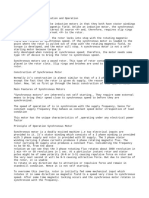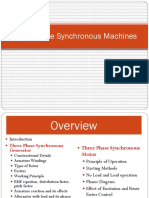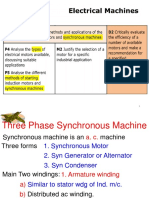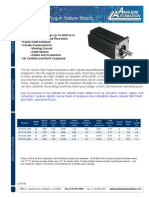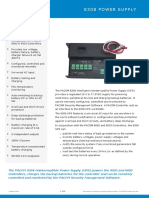Synchronous Machines
CHIMONO
�Synchronous Machines
• An electrical machine is an energy converter.
• It converts mechanical power to electrical power when working
in the generator mode and converts electrical power when
working in the motor mode.
• In both case energy conversion takes place in the presence of a
coupling magnetic field
• In synchronous machines the rotor rotate in synchronism with
rotating magnetic field
�Synchronous Generator operation and
construction
• A DC current is applied to the rotor winding, which then
produces a rotor magnetic field.
• The rotor is then turned by a prime mover (eg. Steam, water etc.)
producing a rotating magnetic field.
• This rotating magnetic field induces a 3-phase set of voltages
within the stator windings of the generator.
�Synchronous Generator operation and
construction
• “Field windings” applies to the windings that produce the main
magnetic field in a machine, and
• “armature windings” applies to the windings where the main
voltage is induced.
• For synchronous machines, the field windings are on the rotor,
so the terms “rotor windings” and “field windings” are used
interchangeably
�Synchronous Generator construction
• Generally a synchronous generator must have :
Rotor Windings or Field Windings
Salient Pole
Non Salient Pole
Stator Windings or Armature Windings
�ROTOR CONSTRUCTION(CYLINDRICAL
ROTOR)
�ROTOR CONSTRUCTION(CYLINDRICAL
ROTOR)
• The field winding is wound on a cylindrical rotor core.
• The rotor of a cylindrical rotor machines which rotate at high
speed
• The rotor will have enormous centrifugal force acting upon it
and therefore the rotor is made of a solid steel core with
longitudinal slots
• The regions forming the centre of the poles are not slotted
• Cylindrical rotor machine have a small diameter and long axial
length.
�SALIENT POLE ROTOR
• The field winding is wound on protruding poles
• Salient pole machines run at low speeds
• The number of poles must be large
• Thus they must have a large diameter.
�SALIENT POLE ROTOR
�FIELD WINDING EXCITATION
• A dc current must be supplied to the field circuit on the rotor.
• Since the rotor is rotating, a special arrangement is required to
get the dc power to its field windings.
• The common ways are:
supply the dc power from an external dc source to the rotor by
means of slip rings and brushes.
Supply the dc power from a special dc power source mounted
directly on the shaft of the synchronous generator
�FIELD WINDING EXCITATION
• Slip rings are metal rings completely encircling the shaft of a
machine but insulated from it.
• One end of the dc rotor winding is tied to each of the 2 slip rings
on the shaft of the synchronous machine, and a stationary brush
rides on each slip ring.
• Some problems with slip rings and brushes:
They increase the amount of maintenance required on the
machine, since the brushes must be checked for wear regularly.
Brush voltage drop can be the cause of significant power
losses on machines with larger field currents.
�• A brushless exciter is a small ac generator with its field circuit
mounted on the stator and its armature circuit mounted on the
rotor shaft.
• The 3-phase output of the exciter generator is rectified to direct
current by a 3-phase rectifier circuit also mounted on the shaft
of the generator, and is then fed to the main dc field circuit
��SYNCHRONOUS SPED
• Stator magnetic field rotates at synchronous speed
• Synchronous speed is given by:
�THE EQUIVALENT CIRCUIT
• The stator phases are identical
• It is thus convenient to develop a single-phase
equivalent circuit of the 3-phase generator.
• The stator winding will have resistance and
synchronous reactance .
• The reactance is composed of :
leakage reactance representing the effect of flux leakage
reaction reactance representing the effect of armature
reaction
�THE EQUIVALENT CIRCUIT
�PHASOR DIAGRAM OF A SYNCHRONOUS
GENERATOR
•
�PHASOR DIAGRAM OF A SYNCHRONOUS
GENERATOR
�PHASOR DIAGRAM OF A SYNCHRONOUS
GENERATOR
���Parallel Operation of AC Generators
• Reasons for operating in parallel:
Handling larger loads.
Maintenance can be done without power disruption.
Increasing system reliability.
Increased efficiency
�Conditions required for Paralleling
The following conditions must be met before switching a
synchronous generator on line:
• The magnitude of the generator voltage and system bus voltage
should be the same
• The frequency of the generator voltage and system voltage
should be the same
• The phase sequence of the generator voltage and the system
voltage should be the same
• The voltages of the generator and bus should be in phase
�Synchronous motors
• Synchronous motors are constructed in the same way as
generators
• The motor converts electrical energy to mechanical energy.
• The synchronous motor only delivers torque when running at
synchronous speed.
• These motors run at constant speed provided the supply
frequency is constant.
�Synchronous motors
• The torque produced in a synchronous motor is a result
of the pull between the rotor and stator fields which are
locked when the rotate together at synchronous speed.
• The magnitude of the torque is determined by the
power angle.
�Synchronous motors
• If we apply a balanced set of three-phase voltages to the stator
with the rotor at standstill and then energize the rotor winding,
the rotating stator field would sweep by the rotor poles causing
a pulsating torque as the north and south poles alternate.
• The machine would not develop any starting torque.
• Thus a synchronous motor must be provided with a means of
starting
�Starting Synchronous Motors
• There are 3 different starting methods available:
Reduced speed of stator magnetic field – the aim is to
reduce it slow enough as such that the stator will have time
to follow the stator magnetic field.
External prime mover to accelerate the synchronous motor.
Damper windings or amortisseur windings.
�Stator magnetic field speed reduction
• The idea is to let the stator magnetic field to rotate slow enough
as such that the rotor has time to lock on to the stator magnetic
field
• the synchronous speed is directly proportional to the supply
frequency.
• By reducing the supply frequency, we can reduce the speed of
the synchronous motor’s stator magnetic fields
• Hence by controlling the speed of the stator magnetic field, you
can lock the stator and rotor magnet easily.
• This is the basic concept behind the variable frequency starting
method
�Starting a Synchronous Motor Using
Damper Windings
• In this method, the motor is first started as an induction motor
and then starts running as a synchronous motor after achieving
synchronous speed. For this, damper windings are used
• Damper windings are additional windings consisting of copper
bars placed in the slots in the pole faces.
• The ends of the copper bars are short-circuited. These windings
behave as the rotor of an induction motor
• When 3 phase power is supplied to the motor, the motor starts
running as an induction motor at a speed below synchronous
speed
�Starting a Synchronous Motor Using
Damper Windings
• After some time DC supply is given to the rotor. The motor gets
pulled into synchronism after some instant and starts running as
a synchronous motor.
• When the motor reaches synchronous speed, there is no
induced emf in the damper windings anymore and hence they
don’t have any effect now on the working of the motor.













